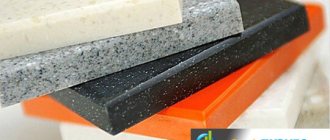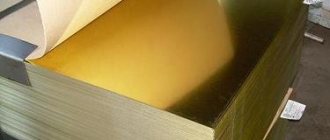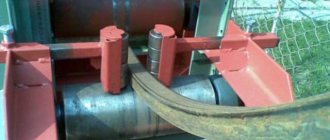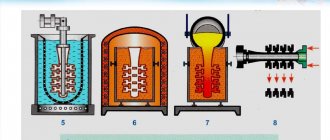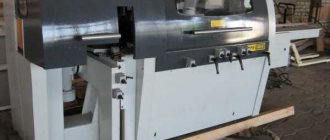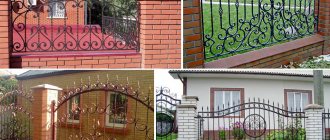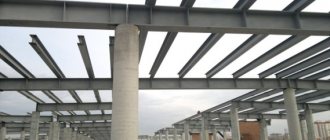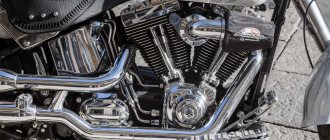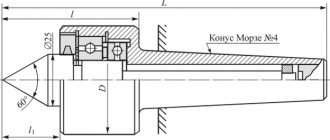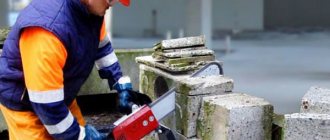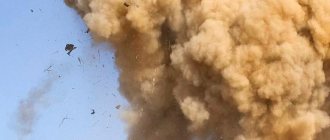The raw materials for the production of veneer and plywood are logs and their sections (churaks) that meet certain dimensional and quality requirements.
For laminated plywood, block lengths from 0.8 to 3.2 m are used, and for sliced veneer – from 1.5 m and above.
The cross-sectional dimensions of the raw material are not of fundamental importance. The minimum permissible size is determined by the economic feasibility of developing raw materials, and the maximum permissible size is determined by the size of the equipment. It is customary to use raw materials with a diameter of 18 cm and above, for sliced veneer - 22...26 cm and above.
Quality requirements boil down to limiting both wood defects (knots, abnormal coloring and rot, cracks, wormholes, etc.) and shape defects (primarily curvature).
The following types of wood are used:
- for the production of laminated plywood - birch, alder, beech, linden, aspen, pine, spruce, cedar, fir, larch;
- for the production of wood laminated plastics - birch;
- for the production of sliced veneer - oak, beech, walnut, maple, ash, elm, chestnut, plane tree, velvet, apple, pear, poplar, cherry, white acacia, birch, alder.
Procurement, delivery and storage of raw materials (logs) at plywood factories are carried out using methods similar to those already discussed. Preparation of raw materials for veneer production involves cutting logs into logs, hydrothermal treatment and debarking.
Cutting ridges into churaki
There are three cutting methods:
- by greatest mass,
- for the highest quality yield
- combined.
The goal of the first method is to obtain from each ridge logs with the largest cubic capacity, regardless of their quality. When cutting using the second method, the goal is to obtain high-grade churaki, regardless of the volumetric yield. Both of these methods are not used in their pure form. A combined method is advisable, which is based on obtaining maximum mass while maintaining the highest quality yield.
Cross-cutting of raw materials consists of two operations, usually combined in practice - marking ridges and sawing them into logs.
Marking consists of determining the cutting lines on the ridge, taking into account cutting out defective places, in order to obtain the largest number of the best quality logs with the least loss of wood.
The cut must be made with strict observance of the perpendicularity of the cutting plane to the axis of the trunk and the correct length of the block.
The logs, depending on the size, are sawn on circular sawing machines (TsPS-710 (Russia) (Fig. 1)) and pendulum machines (TsMZ, TsME-2, TsME-3K (Russia) (Fig. 2)), cross-saw machines with reciprocating motion saws or chain saws.
Rice. 1. Combined balancing circular saw TsPS – 710
Rice. 2. Pendulum circular saw machine TsME-3K
There is a “fox tail” machine with a reciprocating saw motion, used for cutting raw materials with a diameter of 70 to 150 cm.
The total loss of wood when cutting logs into logs is 1-3%, depending on the type of wood.
The productivity of circular saws in blocks per shift (A, blocks/cm) is determined by the formula:
(1)
where T is the duration of the shift, min; U – saw feed speed, m/min; КМ – coefficient of computer time utilization; KD – working time utilization factor; DC – block diameter, m; n – average number of cuts per block.
The logs are cut into logs with an allowance along the length for processing.
To obtain plywood measuring 1525x1525 mm, a block 1600 mm long is prepared, that is, with an allowance of 75...80 mm.
Hydrothermal wood treatment
During the process of peeling and planing veneer, tensile stresses arise in it across the fibers, the magnitude of which can be determined by the formula σ, MPa):
(2)
where E is the modulus of elasticity of veneer across the wood fibers; S – veneer thickness; R – block radius.
Cutting technology is considered as a process of obtaining a thin layer of wood, which must be dense and smooth (not have cracks).
During the cutting process, the layer being removed bends, changing its original shape, as a result of which cracks are possible on the left stretched side of the veneer.
To avoid cracks, the deformability of wood is artificially increased. To do this, churaki and vanches are subjected to hydrothermal treatment (humidification and heating).
The higher the moisture content of the wood, the greater its ductility. Dry wood has significant fragility.
Heating wood (to a certain limit) gives the fibers good plastic properties. High temperatures have a negative effect on the quality of veneer, since due to the strong softening of the fibers during cutting, a “hairy” surface appears.
Recommended temperature for heating wood before peeling and planing:
- Birch, beech, alder – 20…30 оС,
- Linden, aspen – 15...20 оС,
- Mahogany – 30…40 оС,
- Spruce – 20 оС,
- Pine – 40 °C,
- Larch – 50 °C,
- Ash – 50 oC.
Hydrothermal treatment can be carried out by heating in water: boiling or steaming.
Boiling is carried out in hot or warm water in special pools (open and closed), equipped with mechanisms for loading and unloading churak (Fig. 3). This method is simple and does not require large expenses for its organization; it is used mainly for peeling.
Steaming is used mainly in the production of sliced veneer, when cooking is unacceptable due to changes in the color of the wood. Steaming is carried out in autoclaves, steam chambers and pits.
Hydrothermal treatment before peeling can be carried out using soft and hard modes.
Soft – temperature 35...40 oC, heating duration 2...3 days, hard – temperature 70...80 oC, heating duration 2...15 hours.
Rice. 3. Swimming pool with a cantilever gantry crane for warming up churaks: 1 – dumper; 2 - loading conveyor; 3 – ridge storage; 4 – cover; 5 — grab grip; 6 – dividing cabinet; 7 – wall; 8 – tap; 9 – mobile reloader; 10 – unloading conveyor
Hydrothermal treatment before planing is carried out for a longer time: saturated steam temperature 120...130 oC, treatment duration 4...10 hours.
The duration of hydrothermal treatment generally depends on the diameter of the block, the type of wood, the temperature of the heating medium, the initial and final temperature of the wood.
Section 1 CUTTING WOOD AND WOOD MATERIALS
Planing is a cutting process in which the cutting tool moves in relation to the material being processed along a straight path. The cross-section of the chips obtained during planing has the shape of a rectangle. The cutting movement during planing can be carried out by a cutting tool with a stationary workpiece or by the workpiece with a stationary cutting tool. By planing, the product chips are obtained and the surfaces are leveled. Planing can be longitudinal and transverse. With longitudinal planing, the product shavings are obtained in the form of thin boards (shingles). Leveling the surface of workpieces during longitudinal planing is done using ironing and scraping knives, respectively, on planing and scraping machines. During transverse planing, the product chips are obtained in the form of facing (planed) veneer on veneer planing machines according to two schemes: horizontal or vertical. With a horizontal scheme, the main movement (cutting) is performed by the knife, and the movement of feeding the material (logs, beams, vanches). With a vertical scheme, the main movement is made by the material (ridges, beams, vanches), and the feeding movement is made by the knife. The main movement (cutting) in these schemes is rectilinear reciprocating, and the feed movement is periodic progressive.The first scheme is typical for the production of sliced veneer with a thickness of 0.6...0.8 mm, the second - for the production of planks with a thickness of 5...15 mm. When cutting veneer and planks, the knife makes a reciprocating movement. The ridge (timber, vanches) makes a periodic translational movement.
Peeling is a process of transverse cutting, in which a thin strip of chips (veneer) is separated from a rotating material (block) during linear radial movement; knife The process of obtaining a thin strip of wood from a block of wood by rotating it is similar to unwinding a roll of paper. Peeled veneer is used to make plywood, one of the possible modifications of wood widely used as a structural material. Before peeling, churaks are subjected to hydrothermal treatment to increase the plasticity of the wood. Peeling of churaks is carried out on peeling machines. The main movement in peeling machines is made by the block, which rotates relative to the axis of the spindles at a certain speed.
The feeding movement is performed by the peeling knife, which moves continuously translationally in the direction of the axis of rotation of the block.
Peeling thick veneer is more difficult than peeling thin veneer. Bending stresses in thick veneer are significantly higher. In addition, in thick veneer the fields of deformations and stresses caused by crimping are significantly complicated.
The peeling method is widely used to obtain veneer. However, its possibilities are far from exhausted. It can be successfully used in the manufacture of container, pencil and parquet boards and many other materials. The use of this method in the processing of larch, aspen, and other hardwoods is an important modern trend in plywood and board production.
Mechanical and chemical wood processing
According to technological and hardware characteristics of wood
can be classified as follows: Sawing,
planing
, milling, cutting,
peeling
...
Woodworking. Machine tools: milling cutters, drills, planes, chisels
Wood processing
includes: sawing,
planing
, chiseling, drilling, milling, lathe,
peeling
and grinding. For all types of woodworking...
Wood planing. Wood. Tools for processing...
From various planing
tools used for
planing wood
; in the circles of young technicians, sherhebels, planes and jointers are used.
…laminated plastics and veneering of wood products
By peeling
- cutting a layer
of wood
in the form of a continuous... In this case, depending on the plane
of planing
, radial veneer R, semi-radial PR, tangential T and...
Wood. WOOD DEFECTS. Construction Materials
In addition, this defect makes it difficult to process wood
(
planing
and hewing) and reduces its... This defect makes it difficult to process (especially sawing and
peeling
)
wood
and...
>Construction Materials
VENEER. Sheet materials. Peeled veneer. Tangential end…
Wood veneer is thin (0.55 to 1.5 mm thick) sheets of wood
, obtained
by peeling
or
planing
pre-barked and steamed workpieces.
Wood processing with hand tools
…the cutter produces chips in the form of a continuous strip of good quality ( peeling
veneer).
... Planing
is cutting
wood
with knives, in which the cutting path coincides with ...
Wood and wood materials. Wood drying and processing. Veneer…
… wood
- a special group of defects that arise during sawing and
peeling
.
... Compared to the dimensions of the clean parts, the workpieces have allowances for drying, planing
and...
TIMBER of special types of timber - peeled...
3. Peeled timber obtained by cutting wood
in a spiral (
peeling
).
4. Planed
timber, made by cutting
wood
with knives...
...on plywood planing machines (planed veneer), or by peeling (veneer...
- a thin sheet of a given thickness, produced by peeling, planing
or sawing
wood
.
Veneer obtained by planing
is often called
planed
plywood.
Scarification
Baring - removing the bark from the logs before peeling protects the cutting tool from dulling and damage, reduces its wear, and also increases the productivity of the peeling machine.
The main requirements for the debarking process are cleanliness and preservation of the sapwood part of the churak wood (only the bark and bast should be removed).
Raw materials are debarked on various types of debarking machines (OK63-1F, OK80-1, 2OK63-1 (Russia), Valon Kone VK-26 (Finland)) or on peeling machines of a simplified design.
The hourly productivity of rotary debarking machines (A, m3/hour) is determined by the formula:
, (3)
where V is the volume of the ridge of average d, m3; Kz – machine load factor; L – ridge length, m.
For debarking hard and large wood, a hand-held electrified milling tool is most suitable. The rotation speed of its cutter head is 1500 min-1. The maximum thickness of the removed layer is 15 mm.
Peeling on peeling machines is carried out with the ruler withdrawn, that is, without crimping. It is produced on a peeling machine specially dedicated for this purpose, and then the logs are transferred to other peeling machines for processing.
Using this method, debarking is combined with cutting to a cylinder. The resulting partial-size veneer sheets are cut using guillotine shears directly at the machine. The advantages of this method are additional selection of raw materials in the form of pieces, less wear (dullness) of the knife, and increased productivity of peeling machines. The disadvantage is the increased yield of pieces when the block is reinserted into the peeling machine.
The second method is that the debarking operation is combined directly with peeling on the same machine, that is, the debarked block is not removed. To prevent rapid dulling of the knife, the churaki is thoroughly washed beforehand.
Section 3 EQUIPMENT FOR WOOD PROCESSING ENTERPRISES
In the serial peeling machine LU17-10, the block is automatically clamped by the left and right spindles. Spindles are double, telescopic. Peeling of logs with a diameter of 700...120 mm is carried out when clamping with external 8 and 15 spindles with a clamping cam diameter of 110 mm, and further peeling to a diameter of 70 mm is carried out when clamping with internal 9 and 14 spindles with a 65 mm cam. The axial movement of the spindles is carried out by hydraulic cylinders 20 and 21. The cylinders 20 are activated first; they move the inner spindles through clutches with rolling bearings. After the cams hit the block, a pressure switch is activated, which turns on an electromagnet that switches the flow of oil to hydraulic cylinders 21. The compression force of the block of the outer spindles is controlled by a pressure switch, which is adjusted to a pressure of 600 N/cm2.Telescopic spindles installed in the rolling bearings receive rotational motion from the main shaft I through helical cylindrical gears 4, 5, 6 and 17, 18, 19. The rotation of the main shaft is carried out from the electric motor 1 through the V-belt drive 3 by engaging the brake clutch 2 main drive. When compressed air enters the working cavity of the clutch-brake, the rotating pulley engages with the hub of the clutch-brake, as a result, shaft 1 begins to rotate. When air is released from the working cavity, the pulley is disengaged from the hub and, under the action of compression springs, the main movement is instantly braked.
The support 35 consists of a knife holder, a traverse of the pressure line 5 and a crimping mechanism. The caliper rests on the sliders with crescent-shaped supports 36 of the knife holder, which in turn rest on the working surfaces of inclined guides attached to the headstock of the machine. The actual relief angle a decreases during the peeling process (see section 3.6). With the help of such a device, the angle a is automatically changed and the best cutting conditions are created. In addition, a peeling knife and a crossbar of a pressure ruler are installed on the knife holder. The latter is mounted on an eccentric shaft, which with its axles rests on sliding supports located on the side ribs of the knife holder. The support also has the following mechanisms for additionally changing the cutting angle 2\ lifting the pressure ruler 6; adjusting the rear cutting angle L; installation of the pressure ruler 4, 7.
When setting up and setting up the machine, the gap between the working edge of the ruler 9 and the blade of the knife 10, which determines the degree of veneer crimping, is adjusted manually by rotating the handwheel. In this case, through gears 11, 56, 55, 57 and a worm pair 53, 54, the eccentric shaft is rotated at an angle corresponding to the horizontal movement of the clamping ruler traverse to the required amount, controlled by the dial. The degree of compression can be adjusted from the control panel using a hydraulic cylinder 34, which rotates the worm shaft 53 through a rack and pinion gear 33, 52 and a clutch that is constantly engaged under the action of a spring.
The support movement mechanism provides two feed movements during peeling - peeling and working - and two idling movements - bringing the support to the block before peeling and retracting it to its original position after peeling. The accelerated movement of the caliper is carried out when the clutch-brake of the main drive is disconnected from the electric motor 46, mounted on the left headstock of the machine, through a V-belt drive 45, 42, bevel gears 31, 39, 30 and 32, shaft ///, lead screws 50, 51 and sliders 24 and 48, imparting forward movement to the caliper. Before cutting the knife into the block, the caliper switches from rapid feed to rough feed. From the left spindle, through the chain feed 7, 47, 44, rotation is transmitted to a sprocket 41 freely mounted on the shaft with a cam clutch half-clutch 40. When it is turned on using a pneumatic cylinder 28, a rod 38 and a lever 58, the rotation is transmitted through bevel wheels 31, 39, 30 and 32 to the lead screws 50 and 51, which impart to the caliper the forward movement of the stripping feed.
After peeling, the traverse of the pressure ruler is moved to the working position and the working feed is turned on. From the right spindle, through sprockets 16, 23, 25 and 27 of the double-circuit chain transmission and replaceable gears a, b, c, d, rotation is transmitted to shaft 111, on which the safety clutch 29 and the clutch half are mounted on a key. When the clutch 29 is turned on using a pneumatic cylinder, through pairs of bevel wheels 31, 39, 30 and 32, rotation is transmitted to the lead screws, which impart the movement of the working feed to the caliper. The working feed speed, and therefore the veneer thickness, is regulated using replaceable gears a, b, c, d, providing different gear ratios. Sprockets 26, 22, 49 and 43 are used to tension the chains.
As the diameter of the block decreases, its rigidity decreases. When the block diameter reaches 150 mm, the deflection limiter is activated. Its traverse, suspended on two levers to the headstocks of the machine, rotates around an axis from two hydraulic cylinders 10 through a system of levers and rods. Pressure rollers 12 transmit the pressure force of the hydraulic cylinders to the block, preventing its deflection from the influence of cutting forces. At this time, the outer spindles 8 and 15 are removed and the block continues to rotate, held by the inner spindles of smaller diameter.
When the diameter of the peeling block is 70 mm, the working feed is automatically switched off, the support is retracted to its original position, and the additional clamp and internal spindles are also retracted, the remainder of the block (pencil) falls down.
The productivity of a peeling machine is determined by the formula for cycle machines.
The veneer strip coming out of the peeler is cut into sheets of a certain length. For this operation, machines called scissors are used. Modern enterprises use automatic shears equipped with a stacker for stacking veneer sheets. According to the operating principle of the cutting unit, shears are classified into guillotine and rotary.
...prefabricated cutters. knives for milling, planing and peeling machines
Sharpening angle for peelers
18 knives... ... The knives of veneer planing
machines
consist of two layers: the cutting part is made of steel 85VF or 8KhNFT.
Chemical Technology. Equipment for other industries
The production of plywood was associated with the creation of a special peeling
machine
.
For the first time a peeling machine
for cutting wood into thin strips (veneer…
Mechanical and chemical wood processing
Peeling
machines
are mainly used for the production of veneer.
Various types of debarking machines
.
›Materials of the future›
PLANING AND PEELING OF WOOD – Peeling of thick veneer…
Before peeling, churaks are subjected to hydrothermal treatment to increase the plasticity of the wood. Peeling of churaks is carried out on peeling
machines
.
Peeled veneer is produced on peeling machines
It is in veneer that the characteristics of wood as a decorative material, the beauty and originality of its texture are fully revealed. Peeled veneer is produced in peeling machines
…
VENEER. Peeled veneer plywood, joinery and plywood boards…
For the production of peeled veneer from a section of log steamed or soaked in hot water, rotating around its os in a special ( peeling machine)
)
machine
…
VENEER. Sliced and peeled veneer - for the production of laminated plywood...
Churaks measuring 1.5 - 2 m are processed on special peeling
machines
.
After leaving this machine,
the veneer strip, before or after drying, is cut into format...
Wood materials. Types of wood materials. Logs...
It is made on peeling
machines
by cutting a layer of wood in the form of a continuous wide strip tangentially from a rotating, pre-steamed ridge.
›Construction products
Round timber. round timber
Modern peeling
machines
make it possible to obtain veneer with a thickness of 0.5 to 10 mm with virtually no waste.
WOODWORKING. Equipment and tools…
Knives for milling, planing and peeling
machines
.
... Machine tools
cutters drills planes chisels. 5.3. Woodworking.
Peeling of veneer
Peeling of veneer is a process of cutting wood, when the block is given a rotational movement, and the cutting tool is given a translational movement in the direction of the axis of rotation of the block. The process of obtaining a thin tape is similar to unwinding a roll of paper (Fig. 4). The cutting speed is a variable value, since the number of revolutions of the block is constant, and the diameter of the block decreases during the peeling process. The block is clamped between the machine spindles by moving them axially. The rotational movement of the spindles is obtained from an electric motor. The knife is mounted on a support, the movement of which is carried out using a feed mechanism. The maximum length of the processed block (the width of the veneer strip) depends on the distance between the clamping jaws. For modern machines it is within 500...5000 mm. The largest diameter of the processed blocks depends on the height of the centers of the spindles above the bed. In modern machines it is 400...2000 mm.
Rice. 4. Churak peeling scheme
After peeling the block, waste remains in the form of a cylinder, called a pencil, the diameter of which depends on the diameter of the clamping jaws. To reduce the diameter of the pencil, the cams are made telescopic. At the beginning of the peeling process, the block is clamped with external cams having a diameter of 100...110 mm, and then at the end of the process the clamping is carried out with internal cams with a diameter of 55...65 mm.
The veneer thickness is the amount of knife feed per spindle revolution. In the latest models of machines, the thickness range can be within 0.05...5 mm.
When cutting wood freely, cracks and irregularities appear on the left side of the veneer facing the block.
To eliminate them, veneer is crimped using a pressure ruler, which is installed so that the pressure it creates is directed through the cutting edge of the knife. In this case, the gap between the knife and the ruler must be no less than the calculated thickness of the veneer. The degree of compression (Δ,%) can be determined by the formula:
, (4)
where S is the estimated veneer thickness, mm; S0 – distance between the knife and the pressure ruler, mm.
To ensure the required quality of veneer, the degree of crimping must be maintained within 10...30% depending on the type of wood, veneer thickness and block temperature.
When peeling the block, four zones are distinguished (Fig. 5):
The volume of wood in each zone can be characterized by the following figures: flaw zone - 20...23%; zone of long pieces – 4…5%; full-length veneer zone – 57...59%; pencil zone – 15...17%.
Rice. 5. Peeling zones of the block: 1 – flaw zone, which is a consequence of the irregular shape of the block; 2 - zone of long pieces, which is a consequence of incorrect installation of the block between the machine spindles; 3 - zone of full-length veneer; 4 – pencil zone
In the case of peeling wood on a machine equipped with a centering device, the useful yield (q, m3) can be determined by the formula:
(5)
where dch is the diameter of the block, m; dк – pencil diameter, m; lch – block length, m; Kv – coefficient of yield of raw veneer from the block.
The volume of block remaining after peeling (qh, m3) is determined by the formula:
(6)
The volume of a flaw from one block (Q, m3) is determined by the formula:
(7)
where qch is the volume of the block, m3.
The veneer yield is expressed as a percentage of the volume of the block:
(8)
Lump veneer, formed in the initial stage of peeling, is used for the manufacture of small-size plywood or the cores of full-size plywood. The minimum length of selected pieces is 0.8 m, the minimum width is 0.13 m. Proper organization of the selection of pieces increases the veneer yield by 4...4.5%. Currently, the most widely used peeling machines are the brands LU 17-4, LU 17-10, SL-800, SL-1600 (Russia) (Fig. 6); SF 2350 (Italy); Tokyo Pleetwood MK (Japan); MQW2314/35B2 (China).
Rice. 6. Peeling machine SL-1600
The veneer obtained by peeling a block has the form of a strip, the width of which is equal to the length of the block, and the length depends on the diameter of the block and the thickness of the veneer.
At the exit from the peeling machine, the veneer strip is cut into separate strips, the width of which is determined from the expression:
(9)
where Vf is the width of the finished plywood sheet, mm; Δ0 – allowance for cutting (75…80) mm; Δу – allowance for shrinkage depending on the type of wood and sheet size, mm.
Peeling is a process of cross-cutting wood to obtain veneer of a given thickness, in which the cutting path is a spiral.
The flat peeling knife used for peeling should be slightly longer than the log being processed, and its blade should be straight and positioned parallel to the axis of rotation of the log during the cutting process.
The churak is preliminarily subjected to hydrothermal treatment - heating and moistening with water or steam to impart plasticity to the wood fibers, so that the veneer sheet after peeling does not tend to take on the previous shape of the churak, but remains flat.
To obtain high-quality veneer during the cutting (peeling) process, a pressure ruler is used, the edge of which is set parallel to the knife blade. The gap between the edge of the ruler and the knife should be less than the thickness of the veneer. Passing through the narrowed gap, the veneer is compressed, prevents the formation of advanced cracks and is free from chipping of the veneer.
Wood surface sanding is the process of processing parts with abrasive tools to make them smooth. The grinding process, as a rule, completes the mechanical processing of wood, and the evenness of the previous processing (kinematic and technological) is eliminated.
Risks, waves, breaks, and burrs are eliminated from kinematic irregularities during grinding. Grinding eliminates a number of technological inaccuracies - sagging in frames glued together from plots, non-flatness and variation in thickness of slabs, etc. When grinding, a surface roughness class is achieved (GOST 7016). Depending on the design of the machine, the grinding tool has the form of an endless belt, disk or cylinder.
With the advent of new types of sanding papers and special machines, rough grinding with coarse-grained abrasive tools for precise processing of parts to size has become widespread. It is advisable to perform such technological operations as removing sag from carpentry and construction units, calibrating particle boards using the method of rough grinding instead of milling on thicknessing machines.
Grinding is also widely used in finishing technology for enhancing varnish coatings. To achieve high smoothness of the machined surface (but not precision!) during fine grinding, the sandpaper must have more or less soft support on the working part of the machine, for example a felt bed or a pneumatic cushion.
When rough sanding, if more precise finishing to size or to ensure flatness is required, the support of the sandpaper must be rigid.
Grinding wood into industrial chips and shavings is aimed at obtaining wood particles of a certain shape and size.
Technological chips - the initial raw material for the production of pulp and paper production - are used for the production of wood fiber (Fiberboard) and particleboard (chipboard).
Chips of various shapes are used in the production of particle boards and for the manufacture of various types of pressed products and parts.
Shredded wood (shavings, chips) is obtained, as a rule, from low-quality wood raw materials and lump waste from various industries (churak, logs, slabs, slats, etc.), defective parts of various lengths and cross-sections. The particle sizes and fractional composition of technological chips and shavings comply with the requirements of production technology using these raw materials and are regulated by standards.
To obtain technological chips, chippers with a disk and drum cutting element are used. The process of chopping wood in chippers is based primarily on longitudinal cutting of wood. In the production of chips, cross cutting is more often used. In chipping machines, wood is cut according to a milling or planing pattern. When milling, the knives have a stepped cutting edge, which ensures the production of particles of a given length. The thickness of the particles is determined by the amount of feed to each knife.
The production of chips on disc flakers occurs by cutting a layer of wood with knives radially located on the disc using transverse cutting (the line of the cutting edge is parallel to the fibers). The layer of wood to be cut is pre-cut to a depth slightly greater than the thickness of the chips. The distance between the cuts is equal to the length of the chip particles.
Cutting veneer strips
The veneer strip is cut using various types of scissors (NF-18; NF-1803, SL-1700, Finnish APL), equipped with a device for stacking veneer sheets. As a rule, a peeling machine and shears are built into a semi-automatic production line: peeling - cutting - veneer laying (LUR 17-3 consists of LU 17-4 and NF 18-3) (Fig. 7).
Rice. 7. Scheme of the peeling and veneer cutting line
Veneer drying
When gluing, the veneer should have a moisture content of 6...12%. Therefore, the veneer is dried immediately after leaving the peeling department.
Due to the small thickness of the veneer, the stresses arising in it are insignificant. This means that drying can be carried out using more stringent conditions than lumber.
There are the following methods of supplying heat to the dried veneer: conduction, convection, conduction-convection and radiation.
With the conductive method, heat is transferred to the material being dried as a result of its contact with a heated body. This drying method is used in so-called “breathing” presses. They are periodically opened to release steam and are currently practically not used.
With the convective method, heat transfer is carried out through a drying agent: hot air or flue gas. This method is used in belt dryers (a chamber in which air circulates). The veneer moves along specially woven wire belts, which are driven by a special drive. Drying agent temperature 60…120 °C, air speed 0.9…1.1 m/s, drying duration 20…90 min.
With the conductive-convective method, heat is transferred in two ways at once. Roller dryers operate on this principle - chambers, inside of which rollers are located in several rows in height.
With the radiation method, thermal energy propagates through the medium in the form of electromagnetic oscillations in the infrared range. IR rays are capable of heating the surface of wood to a depth of 1-2 mm. In practice, emitters with a temperature of 130-250 °C are used.
The most common today are combined drying units, where the main type of heat transfer is convection with a share of contact heating. These are roller dryers with steam or gas heating. These are continuous dryers in which the veneer sheets are moved from wet to dry end by a system of driven paired rollers. According to the principle of circulation of the drying agent, dryers are available with longitudinal, transverse circulation and with nozzle blast perpendicular to the plane of the veneer sheets.
Steam roller dryers of the SUR type (SUR-4, SUR-5 (Russia) (Fig. 9), “Raute” (Finland)) consist of a loading shelf with drive rollers, eight drying sections, one cooling section and an unloading shelf of five flat shelves The veneer feed is formed by rows of paired rollers rotating in opposite directions (Fig. 8).
Rice. 8. Diagram of the veneer feeding mechanism in a roller steam dryer of the SUR type: 1 – veneer sheets; 2 – upper driven rollers; 3 – lower drive rollers; 4 – air heaters
Steam dryers with nozzle blast (SUR-8 (Russia), VMS "Raute" (Finland)) are a type of steam dryer. They differ in that heat is transferred to the veneer not only from external heaters, but also from the surface of pipes mounted in the nozzle boxes. The drying intensity in such dryers, all other things being equal, increases 2-3 times compared to the drying intensity in dryers with longitudinal and transverse air circulation.
Rice. 9. Steam roller dryer SUR-4
Gas roller dryers (SRG-25, SRG-25M, SRG-50 (Russia), YST-480 “Raute” (Finland)) differ from steam ones in the higher temperature of the drying agent (250...300 °C) due to the use of a mixture of flue gases with air . For this purpose, dryers are equipped with fireboxes where solid, liquid or gas fuel is burned, and flue gases mixed with atmospheric air are directly supplied to the drying zone. Therefore, gas dryers do not have heaters, and with the same frame it becomes possible to make eight floors instead of five.
Belt (mesh) dryers (steam roller dryer SuShL) are used mainly for drying veneer in the form of a continuous belt and are installed in the veneer peeling-drying-cutting-sorting line. The advantage of this method is that veneer losses during cutting and transportation in dry form are reduced by 3...5%, and labor costs are reduced by 2...2.5 times.
Contact dryers are based on the principle of heat transfer to veneer by contact with heated plates. Dryers of this type include, first of all, a breathing press (SUD-4, SUD-7 (Russia)).
A dryer with a staggered roller arrangement takes up less production space and allows you to maintain productivity with less labor.
The duration of drying depends on the temperature of the drying agent, the circulation speed, the thickness of the veneer, the type of wood, the initial and final moisture content of the veneer. Typically, the temperature of the drying agent in steam dryers is 80...150, in gas dryers - 160...300 oC; air speed 1.7...2.5 m/s; Drying duration 3…15 min.
The productivity of roller and belt dryers (A, m3/shift) is determined by the formula:
(10)
where m is the number of veneer sheets per 1 floor; n – number of floors; L – total working length of the dryer, m; b – width of a dry veneer sheet; S – veneer thickness, mm; T – dryer operating time in minutes; Kp – coefficient that takes into account the transition from drying veneer of one type to another (Kp = 0.9 – 1.0); Кз – fill factor of the dryer along the length, (Кз = 0.96 – 0.98); Kv – working time utilization factor; Z1 – duration of passage of veneer through the dryer, min.
After drying, the veneer is sorted.
Veneer manufacturing equipment
It has been established that high-quality peeling of veneer is possible at a wood temperature of at least 20°C. Steaming (holding in hot water) plywood material plasticizes the wood and ensures its high-quality peeling, but you can do without steaming the wood.
Most plywood enterprises in Russia use the following technology for preparing raw materials for peeling:
- acceptance;
- removal and processing of non-commercial wood (firewood);
- storage of raw materials;
- heat treatment of wood;
- debarking of ridges, removal, storage and processing of bark;
- cutting logs into logs, sorting them by diameter and transferring them to the debarking and shelling shop.
Option 1: If wood processing is carried out by boiling raw materials. Cooking is carried out in a special pool (open or closed) for 24 hours. In summer, the temperature in the pool is maintained at 35÷40 ºС, in winter - 40÷45 ºС. To improve the quality of the veneer from which plywood will subsequently be made, it is important that at the welding stage the thermal conditions and time of wood processing are observed.
Option 2: Without boiling the churak! The most important indicator in this option is the temperature of the processed wood! It should be within 20 degrees! In summer, this indicator is observed without any problems, and in winter, heating of churak is possible both in steaming baths and in any rooms in which it is possible to warm up churak to the required temperature. Heating of churaks is possible in chambers with induction heating.
The main parameters of the veneer peeling mode include the humidity and temperature of the log, the angular parameters of the peeling knife and the pressure ruler, and the degree of veneer compression. The moisture content of wood during its heat treatment remains almost unchanged and largely depends on the type of wood and the method of delivery of raw materials. The lowest humidity is characterized by the core zone of pine (minimum 40% for railway delivery), the highest - by birch with false core (up to 160%). The optimal temperature of the logs at the time of peeling depends on the type of wood and the specified veneer thickness. It is believed that the temperature on the surface of the pencil should be at least 20°C.
Debarking and peeling of veneer.
The prepared wood is supplied to the debarking or sawing department.
Option 1: Debarking unsawn logs. It is carried out in special rounding machines. Next, the log is fed to the line for sawing the log into the required length of the logs and then the logs are fed to the peeling machine.
Option 2: Debarking of pre-sawn logs is carried out as follows: special knives of the debarking machine cut the bark and remove it in strips in a spiral. The removed bark is used for heating.
Veneer production and processing
The next stage is peeling the veneer on special machines, where a continuous thin strip of veneer is cut from the prepared block. The thinner the veneer, the more layers there will be in plywood of a certain thickness. The more layers, the stronger the plywood. Birch veneer, compared to other types of wood, is the thinnest: 1.2÷1.5 mm versus 1.6÷2.6 mm for poplar veneer or 2.0÷4.0 mm for coniferous veneer.
At the peeling stage, veneer quality is monitored: samples are taken daily to check thickness and a number of other parameters, and the results obtained are compared with standard ones. Taking this data into account, the peeling machines are adjusted. After peeling the 2.6 meter long veneer, the veneer strip is fed to automatic shears, where it is cut into 1.3 × 2.6 m sized veneer sheets to produce 1220 × 2440 mm plywood. Longitudinal and transverse veneer (for subsequent gluing into one sheet of plywood) is produced on separate peeling lines. On peeling machines, for the production of veneer 1.6 meters long, veneer cutting to width occurs directly in the peeling machine.
The veneer cut into formatted sheets enters the stacker and from there into the veneer dryer.
When completing a line for veneer production, it is possible to install chippers for grinding waste from debarking machines, metal detectors, and photo sensors for monitoring irregular veneer.
Veneer sorting
Veneer sorting can be carried out directly at the dryers, on conveyors that move the veneer to under-stack areas, as well as on specially designated areas. To mechanize the operation of sorting piles of veneer coming from dryers, a dry veneer sorter SSh-3 was developed. Sorting lines with automatic assessment of veneer quality using photo sensors and a built-in computer are used. The system detects dark spots on a sheet of veneer, determines their number, size, area and compares the result with the standards available in its memory, on the basis of which it makes a decision on assigning one grade or another.
The grade of veneer can be increased by repairing. The operation is performed on veneer repair machines of the brands PSh, PSh - 2A, PSh-2AM (Fig. 10), etc. The repair consists of cutting out defects from the sheet and inserting patches of healthy wood in their place. The patch should fit with an interference fit of 0.1...0.2 mm.
Rice. 10. Veneering machine PSH-2AM
It is advisable to join the veneer pieces formed at the beginning of peeling into full-size sheets using the splicing method (with gummed tape, glue thread). To join veneer strips, edge gluing machines RS-5, RS-7, RS-9, RSP-2 (Russia), etc. are used.
250
